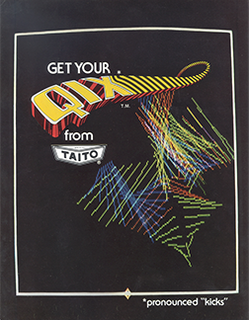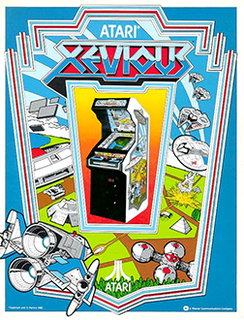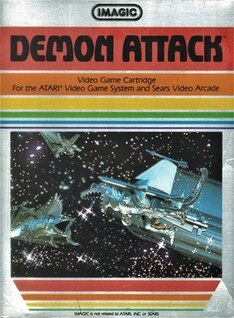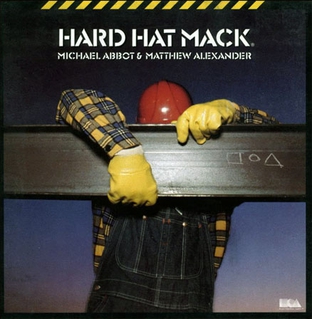
Donkey Kong 3 is a platform shooter video game developed and published by Nintendo. It is the third installment in the Donkey Kong series and it was released for arcades worldwide in 1983 and the Family Computer in 1984, then later released in North America for the Nintendo Entertainment System in 1986. The gameplay departs from previous Donkey Kong games, being primarily a shooter game, and starring an exterminator named Stanley instead of Mario.

Centipede is a 1981 fixed shooter arcade game developed and published by Atari, Inc. Designed by Dona Bailey and Ed Logg, it was one of the most commercially successful games from the golden age of arcade video games and one of the first with a significant female player base. The primary objective is to shoot all the segments of a centipede that winds down the playing field. An arcade sequel, Millipede, followed in 1982.

Qix is a 1981 puzzle video game developed by husband and wife team Randy and Sandy Pfeiffer and published in arcades by Taito America. Qix is one of a handful of games made by Taito's American division. At the start of each level, the playing field is a large, empty rectangle, containing the Qix, a stick-like entity that performs graceful but unpredictable motions within the confines of the rectangle. The objective is to draw lines that close off parts of the rectangle to fill in a set amount of the playfield.

Galaxian is a 1979 fixed shooter arcade game developed and published by Namco. The player assumes control of the Galaxip starfighter in its mission to protect Earth from waves of aliens. Gameplay involves destroying each formation of aliens, who dive down towards the player in an attempt to hit them.

Gorf is an arcade game released in 1981 by Midway Manufacturing, whose name was advertised as an acronym for "Galactic Orbiting Robot Force". It is a fixed shooter with five distinct levels, the first of which is based on Space Invaders and another on Galaxian. The game makes heavy use of synthesized speech for the Gorfian robot which teases the player, powered by the Votrax speech chip. Gorf allows the player to buy 2 additional lives per quarter before starting the game, for a maximum of 7 lives.

Xevious is a vertically scrolling shooter video game developed and published by Namco for arcades in 1982. It was released in Japan and Europe by Namco and in North America by Atari, Inc. Controlling the Solvalou starship, the player attacks Xevious forces before they destroy all of mankind. The Solvalou has two weapons at its disposal: a zapper to destroy flying craft, and a blaster to bomb ground installations and enemies. It runs on the Namco Galaga arcade system.

Tempest is a 1981 arcade game by Atari Inc., designed and programmed by Dave Theurer. It takes place on a three-dimensional surface divided into lanes, sometimes as a closed tube, and viewed from one end. The player controls a claw-shaped "blaster" that sits on the edge of the surface, snapping from segment to segment as a rotary knob is turned.

Choplifter is military themed scrolling shooter developed by Dan Gorlin for the Apple II and published by Broderbund in 1982. It was ported to the Atari 8-bit family the same year and also to the VIC-20, Commodore 64, Atari 5200, ColecoVision, MSX, and Thomson computers.

Jungle King, re-released as Jungle Hunt, is a side-scrolling action game developed by Taito and released for arcades in 1982. It was originally distributed as Jungle King, then quickly modified and re-released as Jungle Hunt due to a copyright dispute over the player character's likeness to Tarzan. Jungle King, along with Moon Patrol released a month earlier, is one of the first video games with parallax scrolling.

Demon Attack is a fixed shooter written by Rob Fulop for the Atari 2600 and published by Imagic in 1982. It was ported to the Intellivision, Magnavox Odyssey 2, Atari 8-bit family, VIC-20, Commodore 64, Tandy 1000, TRS-80, IBM PCjr, and TRS-80 Color Computer. There is also a port for the TI-99/4A titled Super Demon Attack.
1982 was the peak year for the golden age of arcade video games as well as the second generation of video game consoles. Many games were released that would spawn franchises, or at least sequels, including Dig Dug, Pole Position, Mr. Do!, Zaxxon, Q*bert, Time Pilot and Pitfall! The year's highest-grossing video game was Namco's arcade game Pac-Man, for the third year in a row, while the year's best-selling home system was the Atari 2600. Additional game consoles added to a crowded market, notably the ColecoVision and Atari 5200. Troubles at Atari late in the year triggered the video game crash of 1983.
1979 saw many sequels and prequels in video games, such as Space Invaders Part II and Super Speed Race, along with new titles such as Asteroids, Football, Galaxian, Head On, Heiankyo Alien, Monaco GP, Sheriff and Warrior. For the second year in a row, the highest-grossing video game was Taito's arcade game Space Invaders and the best-selling home system was the Atari Video Computer System.
Namco Museum is a series of video game compilations developed and published by Bandai Namco Entertainment for home video game consoles. The first title in the series, Namco Museum Vol. 1, was released for the PlayStation in 1995. Entries in the series have been released for multiple platforms, including the Game Boy Advance, PlayStation 2, PlayStation Portable, Nintendo DS and Xbox 360. the latest being Namco Museum Archives Vol. 2, released in 2020.

Hard Hat Mack is a platform game developed by Michael Abbot and Matthew Alexander for the Apple II which was published by Electronic Arts in 1983. Ports for the Atari 8-bit family and Commodore 64 were released simultaneously. It is part of the first batch of five games from Electronic Arts, and the company calls it out as "truly EA's first game." Versions for the Amstrad CPC and IBM PC compatibles followed in 1984.

Apple Panic is a game for the Apple II programmed by Ben Serki and published by Broderbund Software in 1981. Apple Panic is an unauthorized version of the 1980 arcade game Space Panic, the first game with ladders and platforms. While the arcade original remained obscure, Apple Panic became a top seller for home computers. It was ported to the Atari 8-bit family, VIC-20, IBM PC, and TRS-80.

Märchen Maze is a 1988 isometric platform arcade game developed by N.H. System and published by Namco. Controlling a young girl named Alice, the player must complete each of the game's nine stages while avoiding enemies and falling off ledges. Alice can blow powerful bubbles at enemies to knock them back, and can hit them enough times to send them off the platform. It is the first Japanese adaptation of Lewis Carroll's Alice's Adventures in Wonderland, and ran on the Namco System 1 arcade board.
Koichi Nakamura is a Japanese video game designer. A programming prodigy, Nakamura gained fame while still in high school; in 1982, he entered Enix's first national programming contest and claimed runner-up prize with his entry, Door Door. In 1984, he founded the video game company Chunsoft, where he remains its president.

Vigilante (ビジランテ) is a 1988 beat 'em up arcade video game developed and published by Irem in Japan and Europe, and published in North America by Data East. It is considered as a spiritual sequel to Irem's earlier Kung-Fu Master (1984).

Jupiter Lander is a clone of Lunar Lander developed by HAL Laboratory and published by Commodore in 1981 for the VIC-20. In 1982, it was an early release for the new Commodore 64.

Mutant Herd is an action game written by Jeremy Smith for the VIC-20 and published by Thorn EMI in 1983.
















